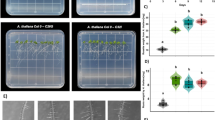Summary.
Insects feeding on Cruciferae recognize their host plants at least partially by means of specific responses to glucosinolates. However, the effects of variations in glucosinolate levels on the acceptability of plants for specialized insects are not well understood. A survey of the literature demonstrated positive, no, as well as negative correlations between plant acceptability and glucosinolate levels. The present study took advantage of the presence of transgenic Arabidopsis thaliana plants with increased glucosinolate levels. Transgenic A. thaliana contain the CYP79A1 gene from Sorghum bicolor. This gene encodes an enzyme which converts L-tyrosine into p-hydroxyphenylacetaldoxime in the biosynthesis of cyanogenic glycosides in S. bicolor. In transgenic A. thaliana plants, endogenous enzymes convert p-hydroxyphenylacetaldoxime into p-hydroxybenzylglucosinolate (sinalbin), which is not found naturally in this plant. The introduction of CYP79A1 resulted in a four-fold increase in total glucosinolate levels in transgenic A. thaliana plants. Although these changes in glucosinolate levels were rather dramatic, they did not have any effects on the acceptability of A. thaliana for the two flea beetle species, Phyllotreta nemorum and P. cruciferae. The flea beetles did not discriminate between transgenic and wildtype plants. Furthermore, they did not discriminate between leaf discs of wildtype plants where different concentrations of p-hydroxybenzylglucosinolate had been applied topically on the leaf surface. Feeding in P. nemorum was stimulated by extremely high levels of allylglucosinolate while this compound had no effect on P. cruciferae. It is concluded that the effect of glucosinolates on adapted insects depends on the chemical or physical environment in which the glucosinolates are found.
Similar content being viewed by others
Author information
Authors and Affiliations
Additional information
Received 29 August 2000; accepted 22 December 2000
Rights and permissions
About this article
Cite this article
Nielsen, J., Hansen, M., Agerbirk, N. et al. Responses of the flea beetles Phyllotreta nemorum and P. cruciferae to metabolically engineered Arabidopsis thaliana with an altered glucosinolate profile. Chemoecology 11, 75–83 (2001). https://doi.org/10.1007/PL00001835
Issue Date:
DOI: https://doi.org/10.1007/PL00001835




